Pork Loin Recipe Dutch Oven
Learn how to make a juicy and delicious Roasted Pork Loin.
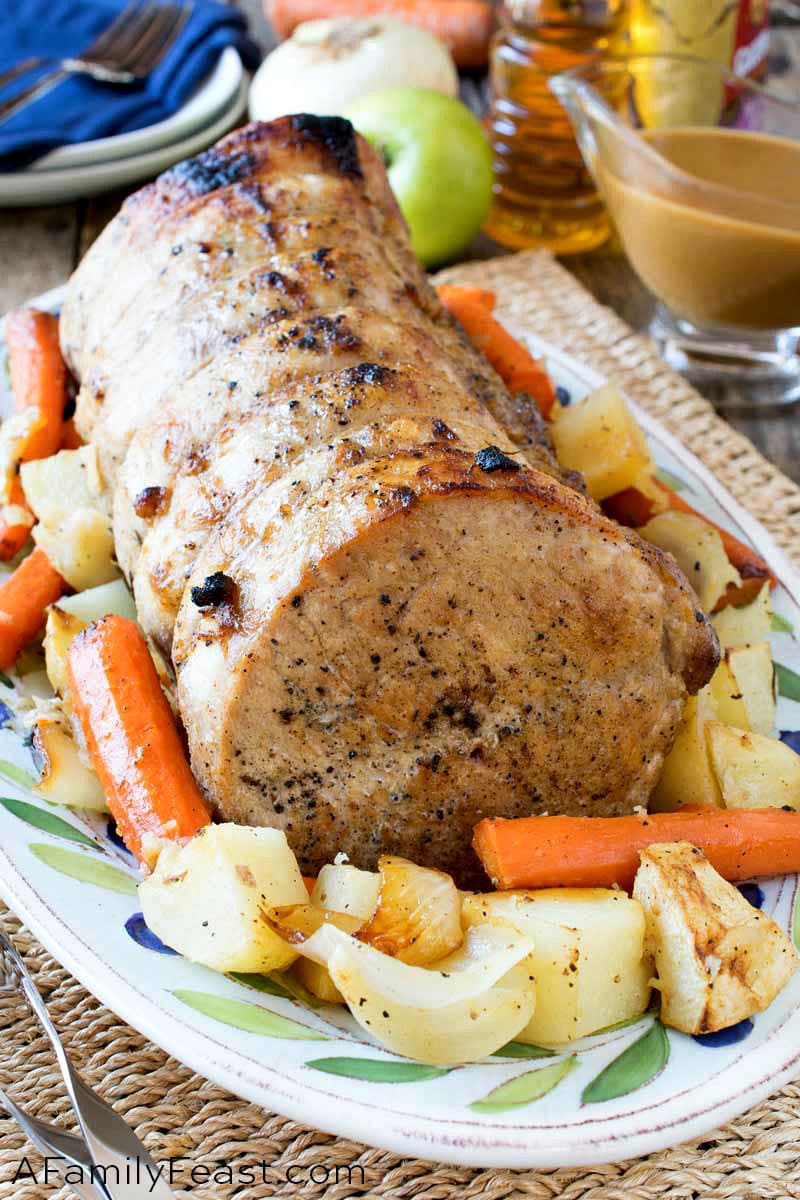
Hi everyone – it's Jack. Pork loins are, in my opinion, one of the most difficult cuts of meat to cook correctly. Most of the time – even at restaurants – they cook up tough, and as dry as shoe leather.
But pork loins are very tempting for budget-conscious cooks. Those long, pre-packaged pork loins (not to be confused with pork tenderloins) at the supermarket are a very affordable option, especially when you are cooking for a crowd.
So, I set out to develop this simple Roasted Pork Loin recipe that turns out very moist and tender.
PIN THIS RECIPE NOW!
Pork Loin Buying Tips
First of all, I'm going to strongly suggest that you avoid the pre-packaged supermarket pork loins, and instead, buy from a reputable butcher. The pre-packaged pork loins are injected with salt water and other ingredients to get the weight up and an attempt to tenderize. I bought one for the purpose of identifying the extra ingredients which include dextrose (sugar), two types of salt, a potato derivative, corn starch, and so on. (Yuck!)
From our local butcher, the center cut pork loin you see in our photos was only $3.99 per pound, and it weighed in at a little over six pounds. With around 10 servings, at that price, you are only talking about $2.50 per serving, so you won't break the bank to get a good, quality cut of meat. (BTW – That pork loin I mentioned above and pumped full of junk – same price: $3.99 per pound.)
Work with your butcher to choose a center cut loin, then ask him to bone, roll and tie (sometimes referred to as BRT) the loin. This gives the loin that familiar, round shape, and the loin will cook evenly throughout.
PIN THIS RECIPE NOW!
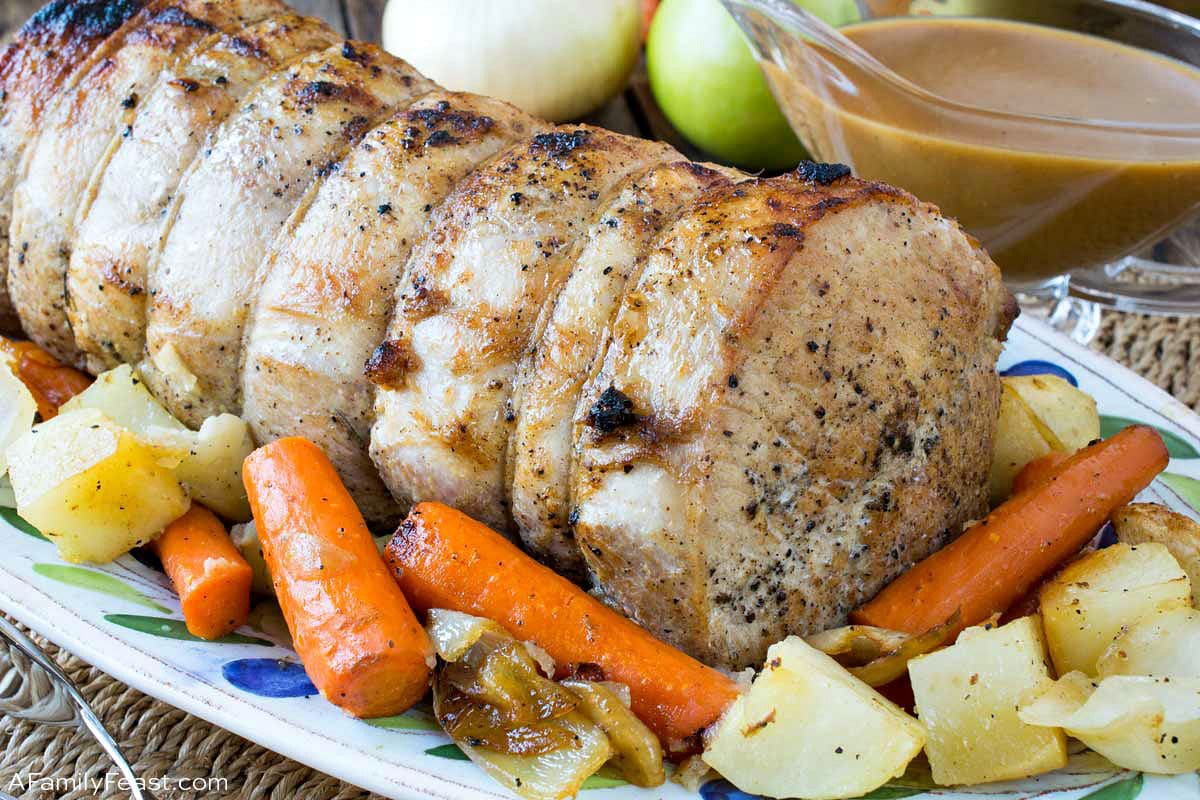
Importance of a Using Probe Thermometer
Most roasted pork loins come out dry and tough because they are over cooked. The best way to ensure that you don't over-cook your Roasted Pork Loin is to use a probe thermometer while you roast it.
The probe stays inserted into the center of the pork loin while it cooks, and it attaches to a thermometer with an alarm that will alert you when the pork reaches the desired internal temperature.
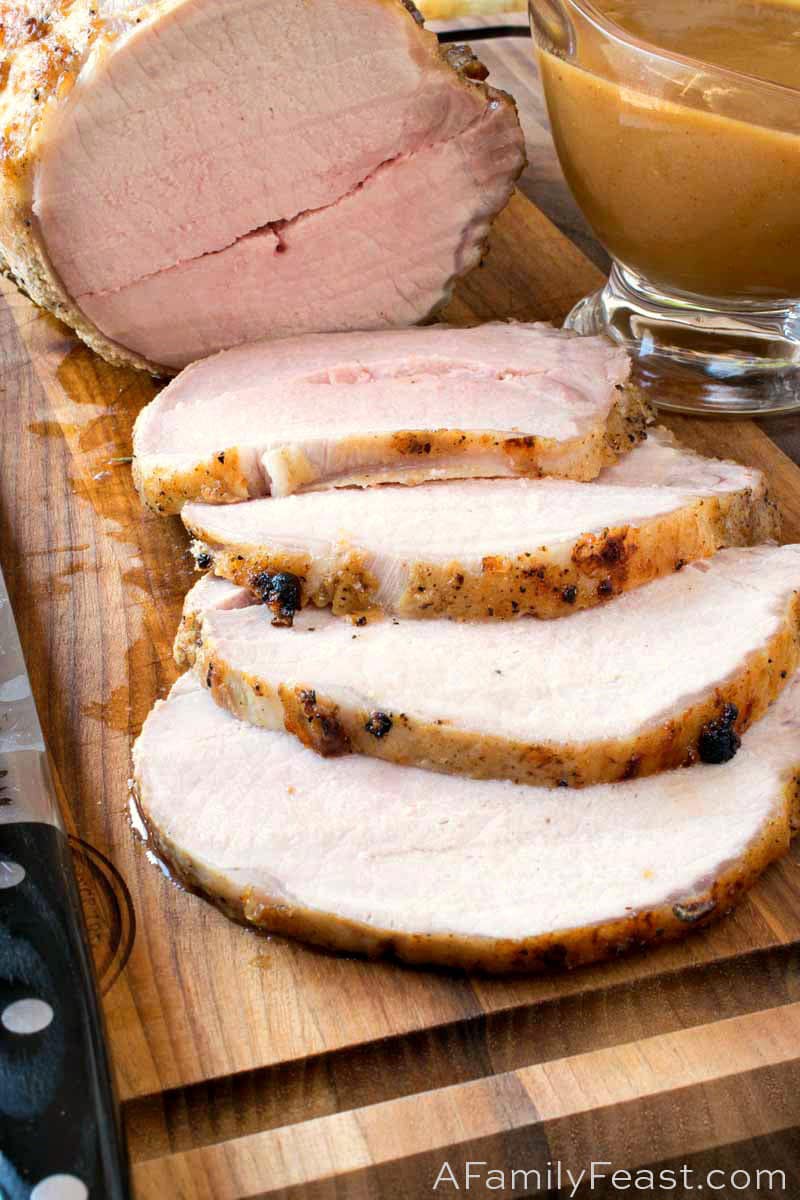
Cooking your Pork Loin
Our Roasted Pork Loin recipe is easy, and it uses simple ingredients you probably have in your kitchen. This recipe also includes roasted vegetables you can serve on the side, and a wonderful gravy to spoon over each serving.
First, dry the pork loin by patting it with a paper towel, then coat with oil and season with salt and pepper. In a large Dutch oven, or a stove-top safe roasting pan, sear each side of the loin over medium high heat. Once it's seared, move the pork to a platter.
Next, deglaze the pan with apple juice – and allow the apple juice to simmer in the pan until it's reduced. Add carrots, onions and rosemary to the pan with the apple juice, as well as some chicken stock.
Place the pork loin back in the pan on top of the vegetables, then brush the pork all over with a mixture of brown sugar, spicy mustard, garlic powder, and a little more apple juice.
Roast uncovered for thirty minutes, then insert that probe thermometer we talked about above. Raise the oven temperature and continue roasting until the pork loin reaches an internal temperature of 140 degrees F. As the pork rests before slicing, the meat will continue to cook from the residual heat, reaching a safe-to-eat internal temperature of 145 degrees.
While the pork rests, add some potatoes and Granny Smith apples to the roasting pan with the carrots and onions that cooked with the pork. Roast until tender.
While the vegetables roast, make a simple gravy with drippings from the pork and a roux. (A roux is a mix of butter and flour which is used to thicken gravies and sauces.)
PIN THIS RECIPE NOW!
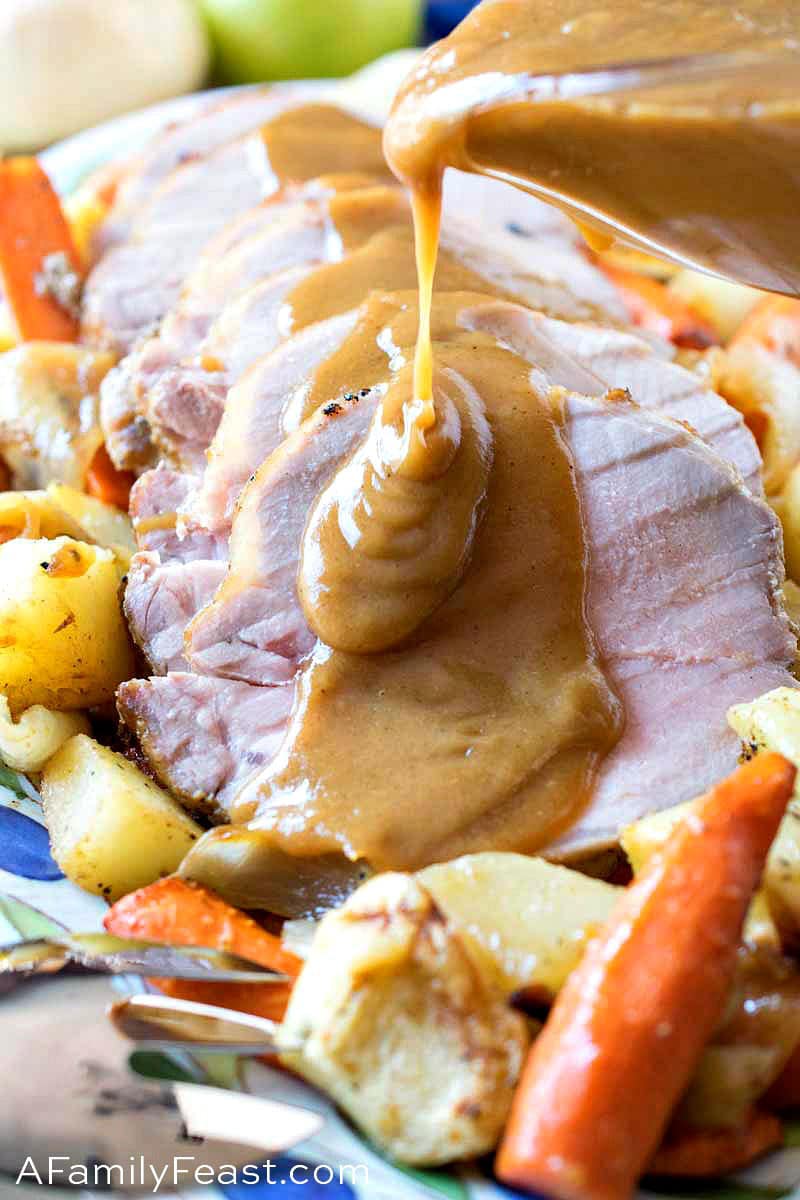
Serve your Roasted Pork Loin
Once the vegetables are roasted and the gravy is cooked, the pork loin will have rested long enough that you are ready to slice and serve.
Slice the pork loin into thin slices and place on a platter or individual plates with vegetables on the side. Spoon the gravy over the sliced pork.
PIN THIS RECIPE NOW!
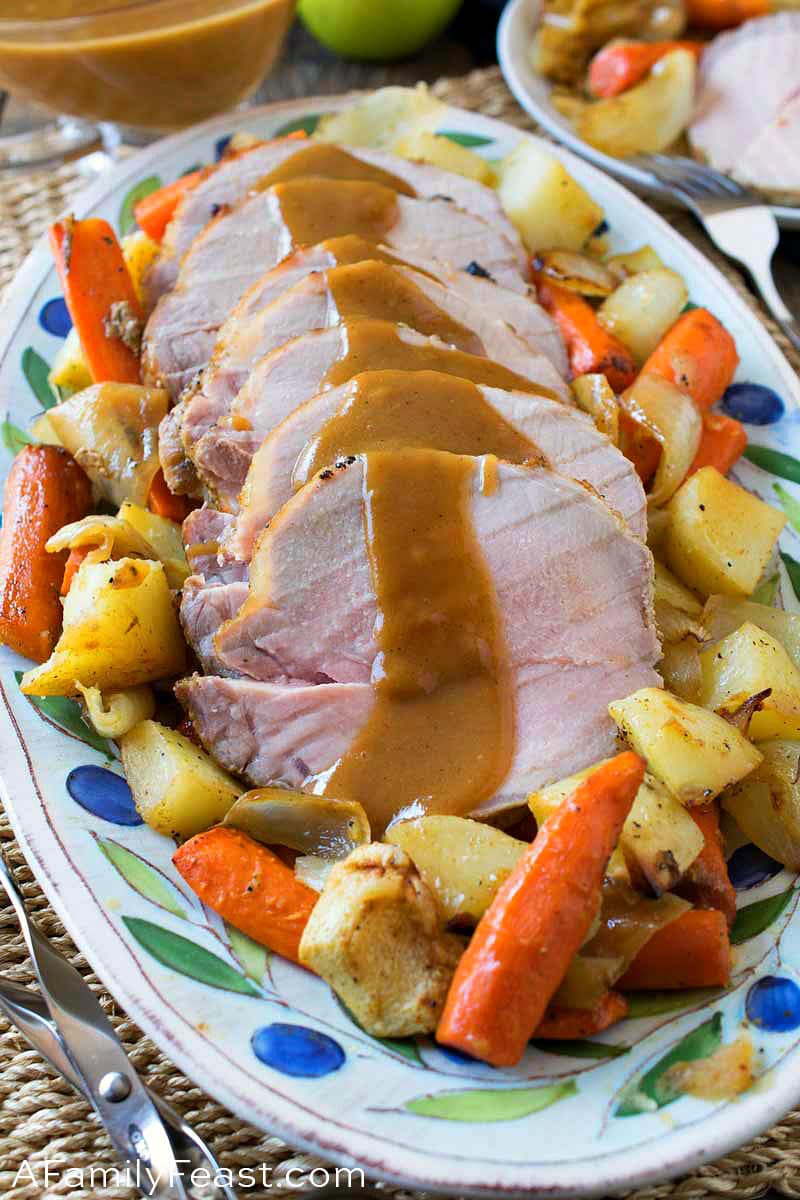
Following this method – and not overcooking the pork – will give you juicy slices of Roasted Pork Loin.
You may enjoy these other pork recipes:
- Pork Pot Roast
- Perfect Pork Tenderloin
- Grilled Porterhouse Pork Chops
- Beer Braised Barbecue Pork Butt
- Perfect Pork Chops
6-pound center cut pork loin, BRT (boned, rolled and tied) *see notes
7 tablespoons extra virgin olive oil, divided
2 ½ teaspoons kosher salt, divided
1 ½ teaspoons freshly ground black pepper, divided
1 cup plus two tablespoons apple juice, divided
2 pounds carrots peeled and left mostly whole, large pieces cut in half so all are uniform in size
3 large Vidalia onions, peeled and cut into eight sections each, 1 ½ pounds total
3 sprigs fresh rosemary, left whole
½ cup brown sugar, packed
½ teaspoon garlic powder
¼ cup spicy brown mustard (we like Guldens)
1 cup chicken stock
4 Russet potatoes, peeled and cut into bite sized pieces, three pounds total
2 large Granny Smith apples, cored, peeled and cut into bite sized pieces
2 tablespoons butter
3 tablespoons all-purpose flour
Preheat oven to 375 degrees F.
Pat the pork loin dry with paper towels and place on a platter and coat with three tablespoons of the oil, two teaspoons of the salt and one teaspoon of the pepper.
In a large heavy bottomed roasting pan or large Dutch oven, large enough to fit your roast, bring a burner to medium high and once hot add two tablespoons of the oil.
When the oil is shimmering hot, add the pork loin fat side down and sear and turn every two minutes for a total of 10 minutes. The roast should be seared on all sides, including both ends.
Remove the roast to the platter and add one cup of the apple juice to deglaze the pan.
After the apple juice is reduced by half and all of the brown bits are up from the bottom, shut the burner off and add all of the carrots, onions and rosemary. Pour the chicken stock over the vegetables, then set the roast back on top of the vegetables.
In a small bowl, mix brown sugar, garlic powder, brown spicy mustard and two tablespoons of apple juice. Use a brush and brush this all over the seared pork roast.
Place the pan in the oven and roast uncovered for 30 minutes.
Remove from the oven and place a probe in one end and set the probe alarm to go off at 140 degrees F. Cover the pan with foil and roast until it reaches 140 degrees F, about one hour or so. Our six-pound roast took one hour and 15 minutes (after the initial 30 minutes) to reach 140 degrees internal temperature. (Smaller roasts may be cooked sooner). Total roasting time was one hour and 45 minutes.
Remove the roast to a platter but leave the probe in to keep the moisture from leaking out. Pour off all liquid from the pan into a sauce pan (about two cups). Cover the roast loosely with foil and let rest while the vegetables are roasting. The temperature will continue to rise as it sits to the finished recommended temperature of 145 degrees F. **
Increase oven temperature to 450 degrees F.
Remove and discard the rosemary. Add the potatoes and apples to the pan with the vegetables and add the remaining 2 tablespoons of oil, the remaining ½ teaspoon of salt and the remaining ½ teaspoon of pepper and toss. Roast for 15-25 minutes until the vegetables are tender. (Check after the first 15 minutes and toss once, then roast for 10-15 minutes more for a total of 25-30 minutes).
While the vegetables are roasting, in a small saute pan, melt butter over medium low heat and add the flour and cook for four minutes to make the roux.
Heat the two cups of the reserved liquid along with any liquid that collected from the resting pork and once it starts to bubble, add all of the roux and whisk to make the gravy. Hold the finished gravy on low, or reheat when ready to serve.
Once the vegetables are cooked, uncover the roast and slice for service, serving the cooked vegetables and gravy with the pork slices.
Notes
BRT means boned, rolled and tied. Work with your butcher to bone a center cut loin, roll it and tie it as seen in our pictures. Stay away from supermarket loins or prepackaged loins and instead buy a good quality product from a reputable butcher.
** Recommended serving temperature of pork is 145 degrees F. Removing the pork at 140 degrees F will ensure that it at least reaches 145 degrees F while it rests. It will in fact go higher however the pork will still be juicy and tender. If left in the oven to 145 degrees F, or higher, the pork will dry out. (For those of you worried about under-cooked pork, trichinosis is no longer a threat because commercially-produced pigs are fed grain and not food scraps. There has not been a case of trichinosis in the US for almost 80 years. Eating medium rare to medium cooked pork is perfectly safe, assuming it was handled properly (like any other meat). Muscle meat from any commercially produced animal, cooked with a little pink is safe to eat, again assuming it was handled properly during the entire process to get it to your table. That said, poultry should be cooked through and not eaten rare (for a whole different reason). But that is a post for another day.
One more note: Nutritional information below includes vegetables and gravy.
Keywords: roasted pork loin, pork loin
PIN THIS RECIPE NOW!
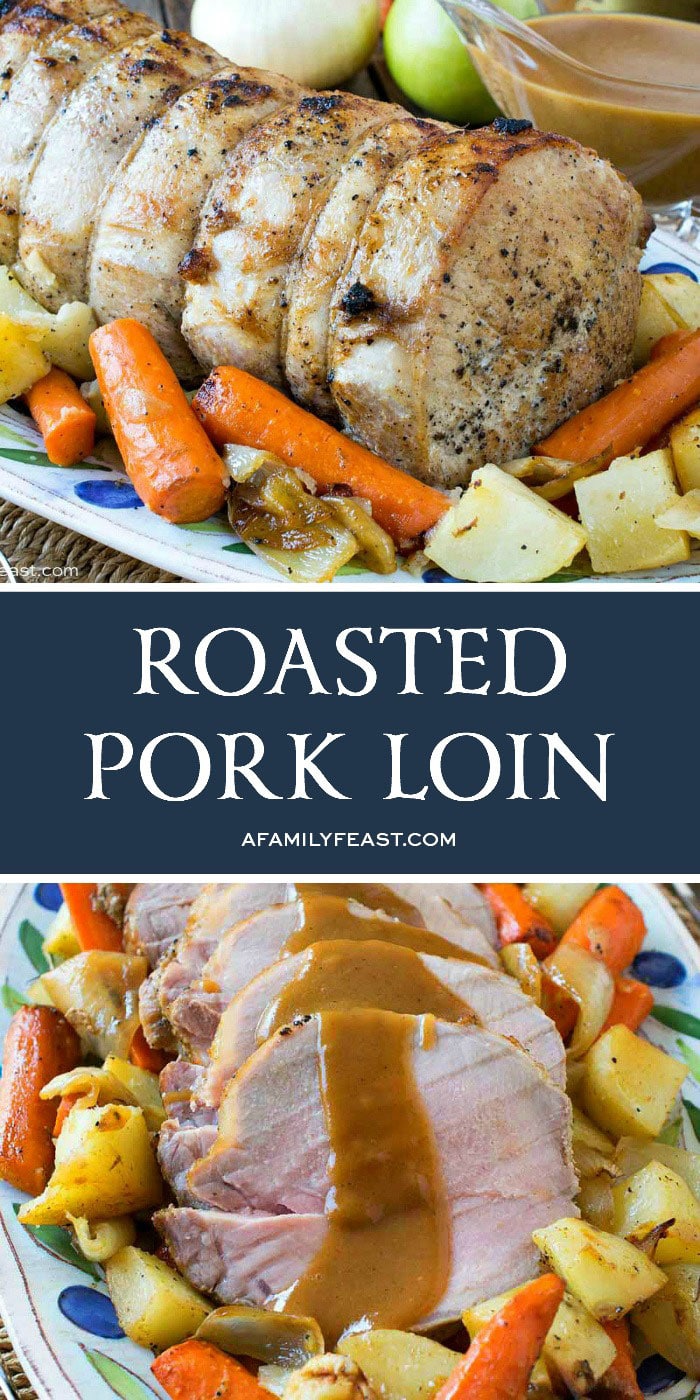
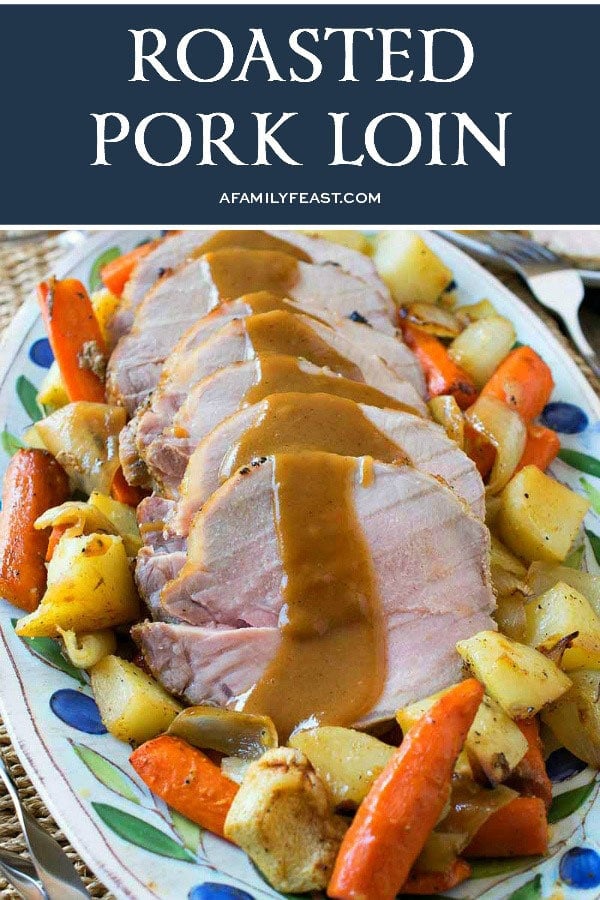
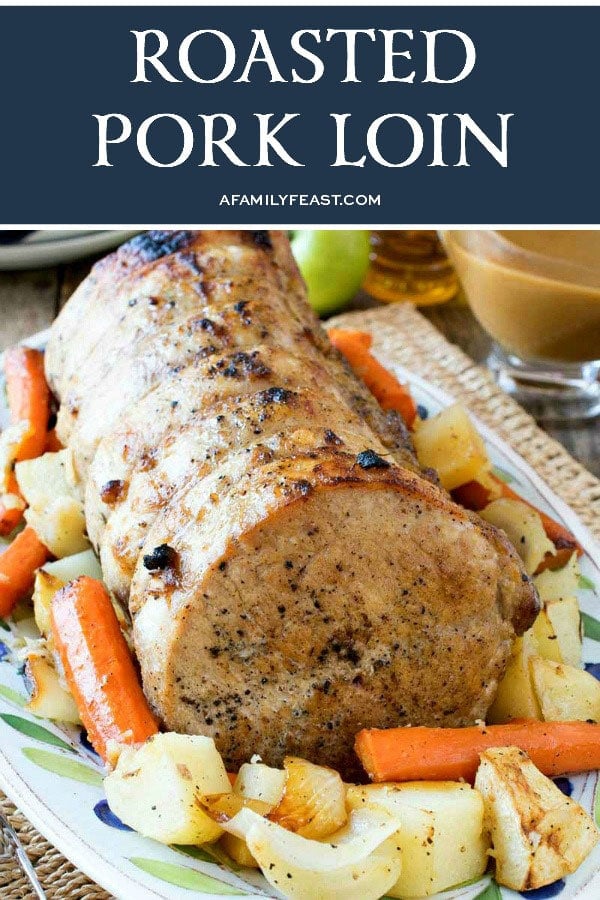
Disclosure
This post contains affiliate links. As an Amazon Associate I earn a small commission from qualifying purchases.
Meet The Author: Jack
Jack is part of the husband-wife team that creates A Family Feast. His love of cooking began very early on and to this day, he gets great satisfaction when someone enjoys the food that he serves. After completing culinary school where he was trained in all aspects of cooking and baking, Jack spent more than 20 years in food service management roles where he managed large-scale public events for politicians, dignitaries, and celebrities, and won several cooking awards along the way. Jack's specialties are soups, breads, meats and fish, and comfort foods.
Pork Loin Recipe Dutch Oven
Source: https://www.afamilyfeast.com/roasted-pork-loin/
Posted by: lanegrosse.blogspot.com

0 Response to "Pork Loin Recipe Dutch Oven"
Post a Comment